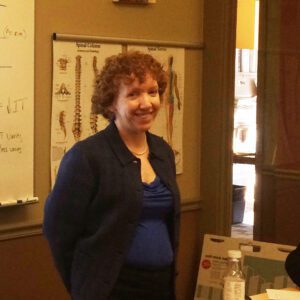
Barbara Minsker, President and Founder of Joyful U, Inc., speaking at our Authentic Leadership workshop.
This guest blog is from Barbara Minsker, President and Founder of Joyful U, Inc., whose mission is to help people discover the path of success and happiness. Barbara recently led a workshop at Independence Plus on mindfulness and resilience techniques for Authentic Leadership.
Mom’s Accident
Last month I was in Durham, NC, completing mindfulness instructor training when I got an email from my 79-year-old mother saying that she had slipped on the icy back steps and fractured a vertebra in her back. It was six days after Mom’s accident, and she was still in considerable pain and getting by on pain medications, which she didn’t like because they made her feel sleepy and disoriented.
One of the participants in the instructor training suggested that I teach my mother how to do a mindfulness technique called the body scan. The body scan involves focusing on different parts of the body and in turn, letting go of any tension or discomfort as the body allows.
So, I called Mom. I asked her to do a body scan by gently focusing on the affected area. With each out breath, I told her to imagine that she was breathing out tension and pain, and with each in breath, breathing in peace and clarity.
Why Mindfulness?
Studies have shown that mindfulness is beneficial for chronic pain (Greeson, 2009). The idea of bringing attention to an area of the body in pain to reduce pain may seem counterintuitive.
However, a recent study in Science (Killingsworth & Gilbert, 2010) shows we are happiest when our mind is present in the moment, regardless of whether we are experiencing something pleasant or unpleasant. Often when we experience something unpleasant, whether physical or emotional pain, our efforts to push away the pain only adds to it.
There is a Buddhist teaching on this idea, called “The Arrow.”
When we get shot with an arrow, such as Mom’s injury, we often shoot ourselves with a second, third, and fourth arrow through our reactions to the first arrow, such as tension, aversion, and even anger. Mindfulness techniques train the mind to bring patience and compassion to the first arrow, which avoids compounding the problem. And in the end, the first arrow may heal more quickly because of our acceptance, or at least be more bearable.
Follow-up with Mom
I called Mom to find out how she was doing. She said the body scan was really helpful and she’d been able to stop the heavy pain medications within a couple of days.
Of course there’s no way to know whether this was natural healing or if she had mastered the techniques quickly enough to experience significantly reduced pain. Most important to me, though, was the fact that she felt more comfortable.
Learn More
Want to learn more about mindfulness? The gold standard in secular mindfulness training is the 8-week course in Mindfulness-Based Stress Reduction (MBSR), which has shown to be effective for treating anxiety, attention disorders, and chronic pain, as well as generally improving productivity, focus, compassion, and decision making. Mindfulness-Based Cognitive Therapy (MBCT) is an adaptation of MBSR for people recovering from depression. These courses are being taught around the world.
For an introduction to mindfulness, I told Mom about Jon Kabat-Zinn’s audio CD Mindfulness Meditation for Pain Relief: Guided Practices for Reclaiming Your Body and Your Life. This CD offers more information about alleviating pain through mindfulness and guided recordings.
Joyful U offers several live online and in-person offerings of MBCT and MBSR. To view openings and register for a live course, go to: http://joyful-u.org/events. For more information, contact Barbara Minsker, President, Joyful U, Inc., at (217) 974-0263 or barbara@joyful-u.org.
Do you practice mindfulness? If so, how does it help you at work with your patients or at home with your family?
References:
Greeson, J.M., “Mindfulness research update: 2008,” Complementary Health Practice Review, 14(1), 10-18, 2009.
Killingsworth, M.A., & Gilbert, D.T., “A wandering mind is an unhappy mind,” Science, 330(6006), 932, 2010.
